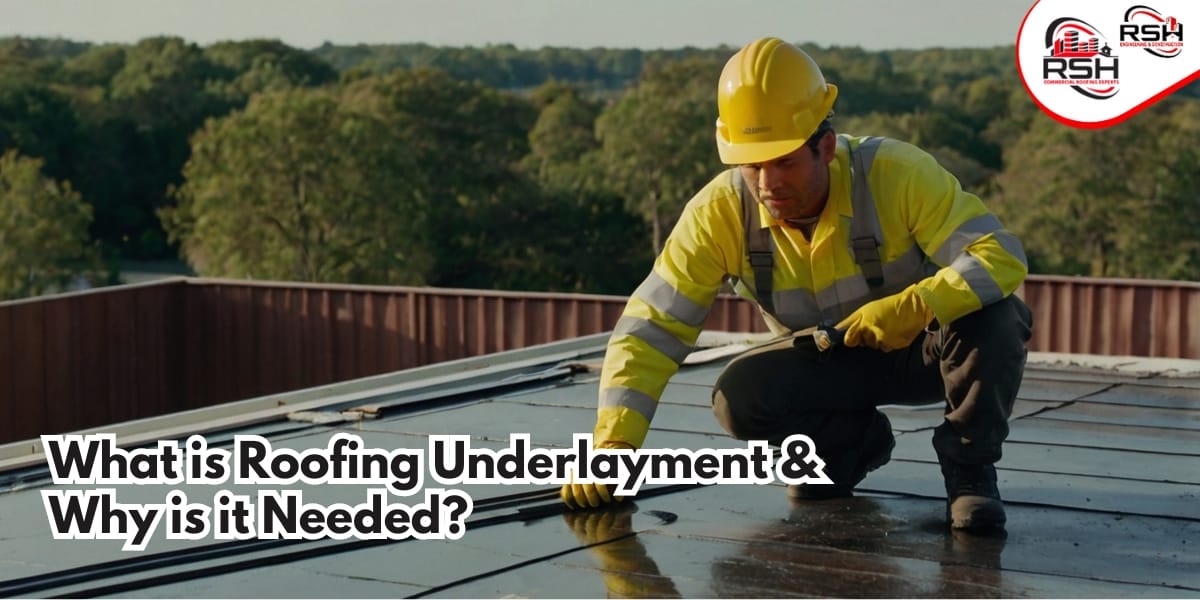RSH Commercial Roofing is a Professional Engineering & Construction Company with 25+ years of experience that specializes in Commercial & Residential Roof Inspections, Repair/Replacement services as well as commercial roofing insurance claims.

What is Roofing Underlayment & Why is it Needed?
When you’re peculiar about your roof, most homeowners focus on the shingles or tiles that make up the outer layer. While these are undoubtedly important for the roof’s aesthetic and protection, an essential component often goes unnoticed- the roofing underlayment.
The roofing underlayment provides full hand support in protecting the home from the elements, ensuring that your roof lasts as long as possible. But what exactly is the working system of roof underlayment, and why is it needed?
Let’s catch up!
Roofing Underlayment: Your Home’s Protector Shield
Roofing underlayment consists of a protective layer between the roof deck (the wooden structure) and the outer portion of the roofing material, such as shingles or tiles. The use of this underlayment is to provide a secondary layer or second protective layer of defense against moisture, leaks, and other environmental damage.
While the roof underlayment’s shingles are crafted for repelling water, these shingles are not always enough to prevent moisture from getting through—especially during severe weather. Underlayment acts as an extra barrier to ensure that water doesn’t reach your home’s interior.
Types of Roofing Underlayment
There are three familiar types of roofing underlayment, each with its unique benefits:
1. Asphalt-Saturated Felt
Asphalt-saturated felt, also known as “tar paper,” is the traditional and most commonly used type of roofing underlayment. It consists of organic materials, like wood pulp, saturated with asphalt to improve water resistance.
Benefits of Installing Asphalt-Saturated Felt
- Asphalt-saturated felt is affordable and has been used for many years.
- It is effective at resisting water, especially during short-term exposure to rain while roofing is still being installed.
Limitations:
The main downside is the roofing underlayment cost. Synthetic underlayment is more expensive than asphalt-saturated felt, but the improved durability often makes it worth the investment.
2. Synthetic Underlayment
Synthetic underlayment is made from woven or spun polyethylene or polypropylene materials, making it much lighter and more durable than asphalt-saturated felt.
Benefits of Installing Synthetic Underlayment
- Synthetic underlayment is highly resistant to moisture, UV rays, and tearing.
- This payment is easier to install because it’s lightweight and comes in larger rolls, reducing the number of seams where water could leak through.
Limitations
The main downside is the roof replacement cost. Synthetic roofing underlayment is more expensive than asphalt-saturated felt, but the improved durability often makes it worth the investment.
3. Rubberized Asphalt Underlayment
Rubberized asphalt underlayment is the premium option, offering a fully waterproof and highly durable membrane. This roof underlayment comprises rubber polymers and asphalt, giving it exceptional flexibility and strength.
Benefits of Installing Rubberized Asphalt Underlayment
- Successfully delivers the highest level of water protection.
- It is often self-sealing around nails, which helps prevent leaks even if the roofing material is damaged.
- Rubberized asphalt underlayment is ideal for areas prone to heavy rain, snow, or ice.
Limitations:
As the most expensive type, rubberized asphalt underlayment is often used in specific areas of the roof that are more vulnerable to water, such as valleys or eaves, rather than across the entire roof.
Why is Roofing Underlayment Needed?
Now that we understand what roofing underlayment is and the different types available. Let’s dive into why it’s so essential for your roof:
1. Moisture Protection
- The primary function of roofing underlayment is to protect your home from moisture. When rain, snow, or ice manages to seep under the shingles, the underlayment acts as a waterproof barrier. Without it, water could penetrate the roof deck, leading to rot, mold, and structural damage over time.
As roofing expert Robert Lynch said, “A roof is only as strong as its foundation, and underlayment is what keeps that foundation dry and protected.”
2. Extra Layer of Protection
- Even the best roofing underlayment shingles can sometimes fail. Strong winds, hail, and other extreme weather conditions can lift or roof damage protection shingles, leaving your roof vulnerable. Underlayment serves as an additional leak and safeguards your roof’s integrity even when the top layer is compromised.
3. Improves Fire Resistance
- Certain types of roofing underlayment, primarily synthetic and rubberized asphalt options, offer improved fire resistance. This is an essential consideration in areas prone to wildfires or where building codes require higher fire protection.
4. Temperature Regulation
- In some cases, roofing underlayment can help with temperature regulation in your home. Preventing moisture from entering helps reduce the chances of mold and mildew growth, which can impact indoor air quality and insulation. Some modern synthetic underlayments are also designed to reflect heat, making your home more energy-efficient.
5. Longer Roof Lifespan
- By providing extra protection against water damage, underlayment helps extend the overall lifespan of your roof. A roof that’s adequately protected from moisture and other environmental elements will last much longer than one without underlayment.
How to Choose the Right Roofing Underlayment?
Selecting the proper roofing underlayment for your home depends on certain factors:
● Climate
If you live in an area with heavy rain, snow, or high winds, investing in a more durable underlayment, like synthetic or rubberized asphalt, is a good idea.
● Roof Material
Different roof materials may work better with certain types of underlayment. For example, metal roofs typically require a synthetic or rubberized underlayment because it provides better protection against moisture.
● Budget
While synthetic and rubberized asphalt underlayments offer superior performance, they are more expensive than traditional asphalt-saturated felt. Consider your budget when deciding, but remember that investing in a higher-quality underlayment could save you money on roof repair plan in the long run.
Conclusion
Roofing underlayment might be out of sight, but it shouldn’t be out of mind. The crucial component of roofing underlayment plays a vital role in protecting your home from moisture, improving fire resistance, and extending the life of your roof.
Whether you choose asphalt-saturated felt, synthetic, or rubberized asphalt, installing quality underlayment is one of the best ways to note your roof’s health in all weather conditions.
As roof contractors Roofing Lynch rightly said, “Underlayment is the unsung hero of a durable, long-lasting roof.” Without it, your home is vulnerable to leaks, rot, and other expensive problems. So, next time you think about your roof, consult with RSH Commercial Roofing Experts. Remember to pay attention to what’s underneath.

